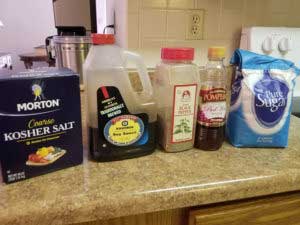
I get many questions in my cooking classes about types of salt. So I feel this is a good opportunity to discuss the many different types of salt available for purchase. All types of salt are identical in chemical composition. All are made from the molecule NaCl or sodium chloride. The difference between types of salt is not in the production or acquisition method, but in the grinding and packaging method. An interesting fact about NaCl, its molecules form an almost perfect cube when they form into crystals.
Salt forms the first step in the seasoning process. This is because it amplifies all other flavors. Also, salt is one of the only seasonings that can actually be absorbed uniformly throughout a food. Because salt naturally exists in all living organisms, all cells can absorb it and will naturally attempt to distribute it throughout a food. This is a side effect of the osmotic process.
When you rub salt on the outside of a pork loin, it creates an over concentration of salt on the outside of the meat. This high amount of salt will pull the moisture out of the pork loin creating a moisture loss inside the pork loin. Then the pork loin will try to absorb that moisture back into the cells to create an equilibrium. This process will occur back and forth over and over again as the excess salt becomes diluted and equally distributed throughout the pork loin creating an equilibrium. This is why when you rub food with salt and let it sit, the exterior will become moist, then dry, and then moist again.
Types of Salt is Defined by Grind
1. Coarse Ground
Coarse ground salts are ground roughly to create large visible flakes of salt. They are best for cooking with because the large visible flakes help keep you from over-salting. In addition to this, they have a lower weight by volume than fine ground salts.
2. Fine Ground
Fine ground salts are the most common type of salts that you will encounter. They are finely ground to make them quick dissolving and easier to dispense from a shaker. They have a higher weight by volume than coarse ground salts. This can often lead to accidental over-salting.
Major Types of Salt
Table Salt (iodized salt)
This fine ground salt is the most common type of salt. You’ll find it in salt shakers in restaurants all around the world. This salt has the added benefit of dietary iodine. It is very easy to over-salt with, making your food exceptionally salty. This is the salt that is called for in baking recipes. If your recipe calls for kosher salt, you can convert it to table salt by removing ⅓ of the amount of kosher salt called for in the recipe.
Kosher Salt
This coarse ground salt is beloved in American restaurant kitchens for its large thin flakes. These large thin flakes help you visually identify the amount of salt that has been applied on the outside of meats. The large flakes also have a large surface area which helps with absorption and even distribution of the salt throughout the food. Because of the large flakes, kosher salt has a roughly 30% lower amount of sodium by volume, making it an excellent choice for those who are salt conscious. That being said, because all salts are made of the same molecules it has an identical amount of sodium by weight.
Sea Salt
Sea salt is chemically exactly the same as kosher salt. This type of salt is simply salt that has been harvested from the sea. It is typically sold in large grinder containers that you grind by hand at home. Often in countries outside of the US, this is the type of salt that is commonly sold. You can also find it finely ground as table salt or coarsely ground for seasoning. The applications of sea salt are defined by the type of grind used. A coarsely ground sea salt with large flakes will take longer to dissolve than thin flat flakes like kosher salt or tiny finely ground salts. Often, coarsely ground sea salt will find its way on top of pastries and pretzels.
Seasoned Salt
Seasoned salt is a finely ground salt that has had herbs and spices infused into the salt. This type of salt is specifically used in the seasoning of meats, especially those to be used in grilling or barbecuing. Because the salts carry the flavors of the herbs and spices, it helps to move those flavors deep into the meat as the salt is absorbed into the meat.
Pink Salts and Other Gimmicky Salts
These types of salts are often touted for their health benefits. I haven’t seen any compelling evidence to show that these salts are any better for you than any other salt. Often inside of the salt crystals, trace elements and minerals can be trapped during the crystal formation process. This is what gives these salts their unique colors. From a culinary perspective, they taste identical to all other salts.
Salt Substitute
Of all of the types of salts listed, this is the only salt not made of Sodium Chloride. This salt is Potassium Chloride (Kcl). It has a similar flavor to NaCl, but it is not quite the same. And, you will taste a difference. Think of it a bit like artificial sweetener. But if you absolutely cannot have salt for dietary reasons, it will do the trick.